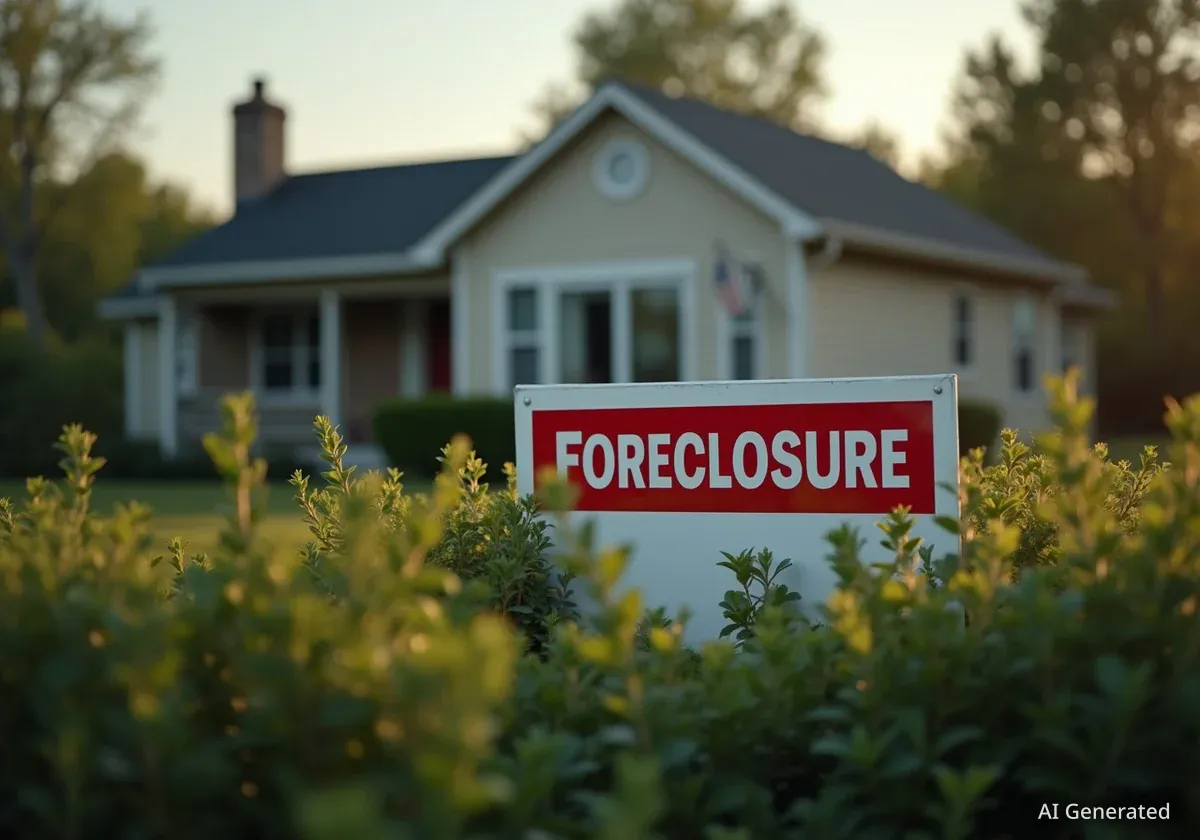Foreclosure filings and bank repossessions in the United States have increased significantly over the past year, signaling a shift from the historically low levels seen during the pandemic. A new report from ATTOM, a leading property data provider, reveals a 17% rise in foreclosure filings and a 33% increase in completed bank repossessions compared to the same period last year.
This upward trend in distressed properties emerges amid a complex housing market. While mortgage rates have stabilized near annual lows, persistent economic concerns are causing potential homebuyers to hesitate, leading to a slowdown in pending sales despite an increase in new listings.
Key Takeaways
- Bank repossessions of homes have surged by 33% from the previous year.
- Overall foreclosure filings, which include default notices and scheduled auctions, are up 17%.
- The increases mark a departure from the artificially low rates maintained by pandemic-era homeowner protection programs.
- Investor activity remains high, with institutional buyers purchasing over 345,000 homes in the second quarter of 2025.
- The market shows mixed signals, as rising inventory has not yet translated into a significant increase in sales from hesitant buyers.
A Closer Look at the Foreclosure Data
The latest figures indicate a notable normalization of the housing market as pandemic-related moratoriums and forbearance programs have expired. Homeowners who face financial difficulties are now moving through the foreclosure process, a trend that was largely paused for several years. The data from ATTOM provides a clear picture of this changing landscape.
Understanding the Increase in Filings
The 17% year-over-year increase in foreclosure filings represents the initial stage of the process. This category includes default notices, scheduled auctions, and bank repossessions. While the number is rising, it's important to view it within a historical context. The current levels are returning toward pre-pandemic norms rather than indicating a market crash similar to 2008.
These filings are a leading indicator, suggesting that more properties could enter the later stages of foreclosure in the coming months if economic conditions for struggling homeowners do not improve. The end of government assistance programs is a primary driver behind this statistical jump.
What Are Foreclosure Filings?
Foreclosure filings are a broad measure that encompasses several steps in the process of a lender repossessing a property due to non-payment. This includes the initial Notice of Default (NOD), the scheduling of a public auction, and the final bank repossession, also known as Real Estate Owned (REO).
Bank Repossessions on the Rise
More significant is the 33% surge in bank repossessions, or REOs. This figure represents the final stage of foreclosure, where the lender officially takes ownership of the property after it fails to sell at auction. A sharp increase here means that more homes are completing the entire foreclosure cycle and becoming bank-owned inventory.
This rise in REOs could add more supply to the housing market, potentially easing some of the inventory shortages that have characterized the last few years. However, the overall number of REOs remains low by historical standards, meaning the impact on national home prices is likely to be modest for now.
The Role of Investors in the Current Market
While some homeowners are facing distress, real estate investors are demonstrating significant confidence in the market. Their activity has reached levels not seen in at least five years, profoundly influencing market dynamics, particularly for first-time homebuyers.
Investor Purchases Hit a Five-Year High
According to recent data, investors purchased more than 345,000 homes in the U.S. during the second quarter of 2025. This accounts for approximately one in every three homes sold during that period, marking the highest level of investor market share in recent history.
Investors, often backed by significant capital, can move quickly with cash offers, giving them a competitive advantage over traditional buyers who rely on financing. This intense competition can drive up prices in certain areas and reduce the number of affordable homes available for families and individuals.
Many investors are focused on the rental market, converting single-family homes into rental properties. This strategy is fueled by strong rental demand and rising rents across the country. The increase in foreclosures may present new opportunities for these investors to acquire properties at a discount.
Mixed Signals for Homebuyers and Sellers
The current housing market is defined by conflicting trends that create uncertainty for both buyers and sellers. While some indicators suggest a cooling market, others point to persistent challenges.
Mortgage Rates and Buyer Hesitation
Mortgage rates have remained relatively stable, hovering near the lowest levels seen this year. In a typical market, this would spur significant buyer activity. However, that has not been the case. Broader economic concerns, including inflation and job market stability, are causing many potential buyers to remain on the sidelines.
This caution is reflected in the latest sales data. Despite an increase in the number of new homes being listed for sale, pending sales have slipped. This disconnect shows that simply adding more inventory isn't enough to stimulate demand when consumer confidence is low.
"Even with more favorable mortgage rates, buyers are not committing. Persistent economic concerns appear to be outweighing the benefits of lower borrowing costs, leading to a subdued market where inventory grows but sales lag."
What This Means for the Market Outlook
The combination of rising foreclosures, high investor activity, and hesitant buyers creates a complex outlook for the remainder of 2025. Several key points will shape the market's direction:
- Inventory Levels: The increase in new listings and foreclosures will add much-needed supply to the market. This could give buyers more choices and slightly more negotiating power.
- Affordability: Despite stable rates, overall home affordability remains a major hurdle for many, especially with home prices still near historic highs in many regions.
- Investor Impact: The high volume of investor purchases will likely continue to support home prices, preventing a significant downturn, but will also keep competition stiff for entry-level homes.
- Economic Factors: The broader economy will be the ultimate driver. A strong job market could restore buyer confidence, while any signs of a slowdown could further suppress housing demand.
In summary, the U.S. housing market is transitioning away from the unusual conditions of the pandemic. The rise in foreclosures represents a return to more normal levels of distressed property activity, not a sign of an impending crisis. However, the market remains challenging, with economic uncertainty and strong investor competition shaping the landscape for everyday Americans.





